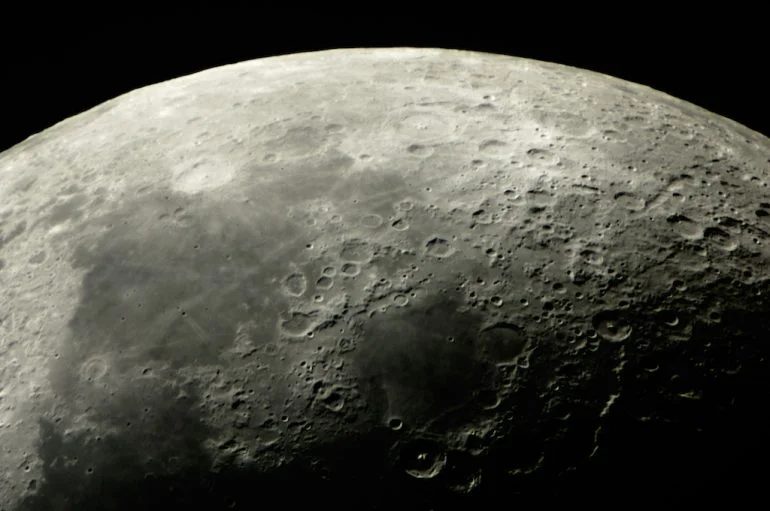A team of French scientists has made a momentous discovery: the Moon has a solid inner core, similar to that of the Earth! This finding, published in the journal Nature, revolutionizes our understanding of our planet's natural satellite. Find out all the details about this discovery in this Inspenet News article.
Scientists used a technique called lunar seismology, which works like an "artificial earthquake." They sent lasers to the Moon and measured how seismic waves bounced around its interior, creating a detailed image of its structure.
In the outer layer, the crust, we find rocks and minerals. Deeper inside is the mantle, a hot and soft layer. And now, thanks to this new study, we know that at the center lies a solid inner core, approximately 258 kilometers in radius.
By analyzing seismic waves, researchers determined that the Moon's inner core is composed mostly of iron, just like Earth's. This discovery suggests that the Moon and Earth may have formed from similar material in the early days of the Solar System.
This discovery represents a milestone in lunar exploration and opens new avenues for understanding the history and evolution of our natural satellite. Future research will focus on studying the characteristics of the lunar core in greater detail, including its exact composition, temperature and state.
The discovery of the Moon's inner core reminds us that this seemingly familiar satellite still holds many secrets to unravel. Space exploration continues to reveal the wonders of the cosmos and expand our vision of the universe.

Virtual aeronautical training? Yes, in a strategic alliance Dufour Aerospace and Loft Dynamics are creating the world’s first virtual reality eVTOL training simulator. This innovative project, aimed at future pilots of the eight-seat Aero3 eVTOL hybrid-electric aircraft, promises to transform aeronautical training. Fabi Riesen, CEO of Loft Dynamics, highlights that this collaboration lays the foundation for the certification of eVTOL simulators.
“Our previous work with helicopters, which are extremely complex to simulate, gives us a significant advantage,” he says. Thomas Pfammatter, CEO of Dufour, adds that virtual reality allows pilots to familiarise themselves with advanced concepts in a safe and realistic environment. The result? More effective training and invaluable data for the development of the Aero3. The first simulator will be ready by early 2025.
Jacobs and BaroMar team up to develop a subsea energy storage pilot off the coast of Cyprus. The system uses mature marine energy and systems technologies, taking advantage of hydrostatic water pressure to reduce installation costs and achieve a competitive levelized cost of storage (LCOS). The project targets 70% efficiency, addressing the challenges of intermittent renewables.
Jacobs Vice President Fiachra Ó Cléirigh highlighted the importance of geophysical and bathymetric surveys for installing tanks at significant depths. Yonadav Buber, CEO of BaroMar, underlined the need for cost-effective and sustainable storage solutions to support global net-zero emissions goals. Will this technology be the future of energy storage?
AI is here to inspect pipelines. DroneLab presented its SkyQUBE drones at Pipeline & Gas Expo 2024. These drones offer a faster, safer and more cost-effective solution than traditional methods, transforming the oil and gas industry. SkyQUBE covers large distances at higher speeds, reducing costs and risks for personnel. It captures images and sensor data to identify potential problems.
The AI embedded in SkyQUBE V2 enables large-scale inspections in an efficient and scalable manner. SkyQUBE AI-powered drones are the future of pipeline inspection, offering unprecedented efficiency, safety and scalability. With this technology, DroneLab is leading the transformation of this industry with its innovative approach.
The £2.5 billion Eastern Green Link 1 (EGL1) project, a subsea highway, is close to starting construction, transporting green energy from Scotland to England via a high-voltage power cable. Transmission infrastructure is critical to the UK achieving its net-zero emissions ambitions, but it goes much further. Eastern Green Link 1 will be transformative, driving economic growth across the UK, enabling the rapid growth of renewables and helping to ensure greater UK energy independence.
This 196km link will power around two million UK homes, boosting economic growth and improving energy efficiency. Ofgem has backed the project, which will make a significant contribution to the country’s net-zero emissions ambitions. The energy of the future is about to be submerged under the sea!
For more content related to the event visit https://inspenet.com/inspenet-tv/ and our Youtube channel.